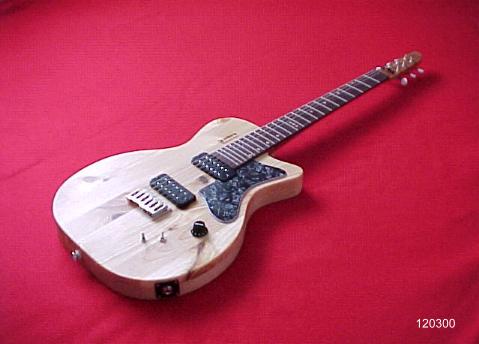The first of the "IKEA" guitars in a series of possibly three.
This is one of the most interesting guitars I ever built and it is also one of the best.
The action is great, the tone is unbelievable, the neck is super fast, tuning stability is as good as it gets. In short, everything just worked out great on this guitar. This amazingly figured top is from Ikea Furnishings. I bought one of their unfinished end tables for $15 and I can get three guitar tops from it. What a shame that they would use such amazing "tone-wood" for their cheap furniture. Its a sacrilege.
I introduce several new things in this guitar. I use DiMarzio Virtual P90 pickups for the first time and I love them. They are powerful and have a lot of guts. Its some kind of a midrange tone which screams Texas blues and Billy Gibbons.
I also used a narrower string spacing at the bridge to accommodate these soapbar pickups. This guitar has the narrower Gibson string spacing as opposed to the wider Fender spacing I usually use. This is also the first guitar which uses all nickel plated hardware. My bridges are now also available in nickel plating and this guitar has all nickel plated hardware instead of chrome. Other manufacturers routinely mix nickel plated parts with chrome plated parts and it doesn't look right if you have an eye for detail like I do.
I was not happy with the mounting screws supplied with this style of pickups so I searched hard for a better alternative. I came up with some extremely hard to find black machine screws which screw into metal inserts instead of the soft wood of the guitar. I also use these inserts and screws for the control cover. Very clever, wouldn't you say?
I invite anyone to compare this guitar to any other guitar you may own or wish to own, regardless of price. Put it up against any overpriced, over-hyped guitar on the market today. Compare it to any vintage guitar for tone and playability. Walk into any music store, give it to the head honcho and ask him to find a guitar on his rack which is better.
Body - multi-piece knotty pine with a gorgeous AAAA-private stock IKEA top
Neck - one piece Mahogany with Rosewood fingerboard
Pickups - DiMarzio Virtual P90
Scale - 24.75
It is well documented that the owner of IKEA was a person of interest after the war concerning his Pro- Nazi beliefs. Ironicly out of his structured, utilitarian, cold, neat, structured world of boring "furniture" comes an instument of great creativity and chaos. Ironic.February 23, 2007 9:16 AM
Bernard van Kerrebroeck- de Sonnneville said...

Hi. So, I'm sure you know by now you got blogged on Make. Yeah, that's where I found you. I looked at that IKEA guitar that you said had such good sound. Interestingly, the laminations in two directions: strip laminations for wide planks and then two of those planks sandwiched together. You used the phrase "tone-wood". I suspect it's not the wood itself such much as the lamination technique. That's why I'm writing. If its the technique, not the wood, there's something pretty interesting going on.
Background. I studied physics and mathematics at Berkeley. I've done woodworking and am tooling up to do novel instruments in metal.
A lamination boundary has a different internal structure than the wood itself. For most modern glues, the joint is stronger than the wood. This is particularly true for the radio-frequency cured glues that are used in commercial laminating machines. The lamination boundary acts like a half-silvered mirror with respect to sound; it passes part of the sound and reflects part of it. A strip between two such boundaries is a resonator. A fence of laminated strips, therefore, has a resonant frequency that arises from the lamination structure itself. It's frequency depends upon both the dimensions and the wood used.
What's interesting to me about that there are three different lamination dimensions in that table top. There's the strip width on the top, that on the bottom, and the depths of the layers (which look equal to me). If these dimensions have effective-integer ratios, the resonant frequencies will as well. The actual ratio is not precisely the same as the strip width, because the glue joint is not infinitely thin. It has some effective width that decreases the resonant width of the strip.
Anyway, I thought you might be interested in that insight. If you get curious about it, and if you have the right machines in your shop to experiment with laminations (jointer, thickness planer, vacuum press), you might try building some of your own multi-laminated tops and see how they sound. Eric